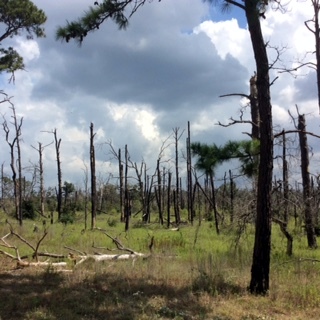
(Explanation here.) We spent Thursday afternoon and all of Friday in the town of Giddings, Texas, for the 10th Annual Word Wrangler Festival. The organizers gathered together more than thirty writers, for a community bash at the library/community center, followed by bringing in busloads of school children to the library to meet the lot of us, talk about our books, and to encourage them to explore books … it was a lovely way to spend the day. And we were faintly boggled on the drive up to discover that yes, there is actually some deep pinewood forest in this part of Texas. (The woods on the opposite side of the highway were relatively un-scorched by the fire.
And we brought home take-out BBQ brisket, pork and chicken from the Giddings City Meat Market, which is supposed to be one of the top best BBQ places in the state,
Yes, these are the Lost Pines. The fires of some years back did enormous damage to them. Also many people lost their homes.
Oh, yes — we could see where the fire burned, and where the firefighters had been able to hold it back, and where there were new-built homes, here and there.
Not much of a comfort to those who lost homes, and loved the deep green forest … but there was already a lot growing back, new and green.
Reminds me again of what Dad often said — the ecology of certain biomes depends on naturally-occurring fire every interval of so many years. Put it off, and let the duff and brushwood build up? When the fire comes, it is ever so much the worst.
Still – we were blown away by how deep and lovely the unburned bits were. It was so unexpected, since we have gotten so accustomed to basically grass meadows with the occasional grove of oaks. Blondie said that it looked like parts of North Carolina, so lush and green, with tall thick pine trees!
Regarding fire management and how it relates to other complex systems like the economy, here is a classic post from Ashwin Parameswaren, AKA Macroresilience:
http://www.macroresilience.com/2011/06/08/forest-fire-suppression-and-macroeconomic-stabilisation/
Stabilization is the enemy of growth and resilience.
I remember driving through parts of Utah where wildfire had recently burned. Eerie and strangely sad.
Sgt. Mom – The Lost Pines are a surviving enclave of a former great pine forest once covering Northeastern Texas. I don’t know if you have been over to the part of Texas near the Louisiana and Arkansas border but there is a lot of natural beauty there extending also up into eastern Oklahoma and western Arkansas.
Grurray, interesting article. Thanks.
Was some of the article truncated? It ends with a comma. Only went to one BBQ place in TX; a friend took me to the Cyclone BBQ near Temple TX (outside Waco) Waylon and Willie were piped in all the time and I kept drinking Shiner Bock and eating Brisket until I couldn’t take it anymore.
http://cyclonecorralbbq.com/
No – it was a short article, and I posted in a hurry.
I didn’t know there are or once were pine forests in Texas. But all I know about Texas is from Western movies.
==============================
IRRELEVANT side note: the pics of the ex-forest reminded me of a joke:
Sherman: Mr. Peabody, there are no trees left in this forest!
Mr. Peabody: That’s right Sherman, this is the Are-Gone Forest.
The trouble is, Larry – that what people know about Texas is what they see in Western movies … which is usually far west Texas. High desert far west Texas. It escapes the movie makers that large tracts of central and eastern Texas are woods, semi-swamp, bayous, soggy coastal plains, or rolling hills, with acres of pine woods, oak trees, and cypress swamps as local conditions dictate.